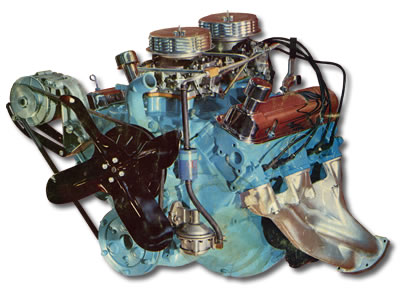 |
| The mighty 421 Super Duty Engine. Differences on this engine are the Alternator and brackets. 1962 421 SD engines were equipped with a generator. This engine is also equipped with Aluminum Exhaust Manifolds which would simply melt if subjected to ordinary street use due to the excessive heat. The engine was rated at 405HP, but its true output was much higher. |
1962 Pontiac Super Duty - 421
It stands without question that the 1962 Pontiac Super Duty was Pontiac's pinnacle year in drag racing, NASCAR and other racing events. Pontiac was on top of its game in 1962, following a mandate handed down by the officials of the NHRA, vehicles wanting to race in the Super Stock class must be Factory released. In previous years Pontiac got away with shipping factory low-compression equipped vehicles to racing super stars like Mikey Thompson and Arnie "The Farmer" Beswick. Hidden in the trunks however were the racing goodies, Forged Steel 421 Blocks, Forged Pistons, Forged Crankshafts, assembled high compression heads (#127) and many other racing goodies. All late 421 engine blocks were produced with a .030-inch overbore, technically giving the engine 428 cubic inches. Cylinder heads are the 1960-1961 high-performance type with 1.92-inch valves and 1.66 exhausts, undercut valve heads and 1.65-to-1 rocker arm ratio to give it high valve lift without excessive acceleration of the lifter-pushrod mass. The cam was a No. 10 McKeller solid lifter giving it 308 degrees intake duration and 320 degrees of exhaust. Factory recommendations state a maximum of 5500 rpm with the standard dual valve springs. Lower engine components include special heavy duty connecting rods, Moraine aluminum bearings, Mickey Thompson forged pistons giving it 11.0-to-1 compression, four bolt main bearing caps, heavy duty oil pump and special six-quart oil pan, light weight flywheel with heavy duty clutch and clutch counter-shaft. Typically the engines were setup loose from the factory for minimum friction. Pistons were .009-.013 inch skirt clearance, .002-.003 bearing clearance, with .030-.035 side clearance on the rods. Piston Slap sounded like a boiler factory when started cold and improved only slightly when warm! Carbs included two big Carter AFB four-barrel carbs mounted on an aluminum manifold, which did not include a provision for exhaust heat in cold weather. Carter AFB carb numbers were 3433S FRONT and 3435S REAR, manual choke style system was provided, throttle linkage was straight mechanical style. Special dual-point distributor had no vacuum advance and uses allot of spark advance. Factory recommendations include an initial setting of 10 crank degrees with another 27 degrees in the distributor achieving a healthy 37 crank degrees advance on the top end. Exhaust system used the unique "Pulse-Flow" dual-outlet cast-iron exhaust headers with huge 3-inch outlets, two on each side. Special casting which bolts to the header outlet flange with a 3 inch opening on the side and an adapter for a 2.25 inch exhaust pipe on the back. Side openings can be uncapped to free the exhaust during a drag race. When capped exhaust flows through dual low-restriction mufflers that give a maximum of quieting with minimum backpressure.1962 Pontiac Super Duty Engine Codes
| Engine Code | Cubic Inch | Horsepower | Tourqe | Transmission | Carbs |
| 13B | 421 | 405 | 605 | 3-speed | 2 x 4 |
| 13U | 421 | 405 | 605 | 4-speed | 2 x 4 |
| BU | 421 | 410 | 605 | 4-speed | 2 x 4 |
| BT | 421 | 410 | 605 | 4-speed | 2 x 4 |
Engine Specifications
| All late 421 engine blocks were produced with a .030-inch overbore, technically giving the engine 428 cubic inches. Cylinder heads - high-performance type with 1.92-inch valves and 1.66 exhausts, undercut valve heads and 1.65-to-1 rocker arm ratio to give it high valve lift without excessive acceleration of the lifter-pushrod mass. Camshaft - No. 10 McKeller solid lifter giving it 308 degrees intake duration and 320 degrees of exhaust. Factory recommendations state a maximum of 5500 rpm with the standard dual valve springs. Heavy Duty connecting rods Moraine aluminum bearings Mickey Thompson forged pistons giving it 11.0-to-1 compression (Typically the engines were setup loose from the factory for minimum friction. Pistons were .009-.013 inch skirt clearance, .002-.003 bearing clearance, with .030-.035 side clearance on the rods. Piston Slap sounded like a boiler factory when started cold and improved only slightly when warm!) Four bolt main bearing caps Heavy Duty oil pump and special six-quart oil pan Light weight flywheel with heavy duty clutch and clutch counter-shaft. Carter AFB four-barrel carbs mounted on an aluminum manifold, which did not include a provision for exhaust heat in cold weather. Carter AFB carb numbers were 3433S FRONT and 3435S REAR, manual choke style system was provided, throttle linkage was straight mechanical style Dual-point distributor, no vacuum advance and uses allot of spark advance. Factory recommendations include an initial setting of 10 crank degrees with another 27 degrees in the distributor achieving a healthy 37 crank degrees advance on the top end. Unique "Pulse-Flow" dual-outlet cast-iron exhaust headers with huge 3-inch outlets, two on each side. Special casting which bolts to the header outlet flange with a 3 inch opening on the side and an adapter for a 2.25 inch exhaust pipe on the back. Side openings can be uncapped to free the exhaust during a drag race. When capped, exhaust flows through dual low-restriction mufflers that give a maximum of quieting with minimum backpressure. |
OldRide Marketplace
Check out Pontiac items for sale in the OldRide Marketplace.

1965 Pontiac GTO
$129,900

1969 Pontiac Firebird
$45,995

1926 Pontiac Other
$29,000

1969 Pontiac Firebird
$43,995

1977 Pontiac Firebird
$29,495
Recent Articles
Like this article? You might also enjoy these related articles.








